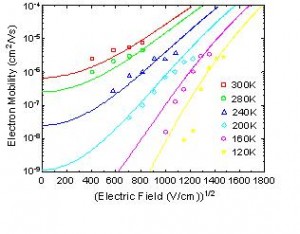Research
Effective temperature models for charge transport
B.N. Limketkai, P.J.Jadhav, M.A. Baldo
The charge carrier mobility in organic semiconductors varies with both electric field, temperature and charge density.[1] Previous studies have predicted a Poole-Frenkel dependence of charge carrier mobility on electric field.[2,3] But to jointly summarize the electric field, temperature, and charge density dependencies of mobility analytic theories have continued to rely on simulation-based empirical models.[4] In this work, we provide a simple theory that matches the current-voltage characteristics of an archetypical organic semiconductor from room temperature to T = 100K. Only three free parameters are required: the width of the density of states, the decay length of the charge carrier wavefunction, and the maximum conductivity, which is dependent in turn on the strength of the intermolecular interaction.
The theory is based on a percolation model. This approach was first introduced by Ambegaokar, et al.[5] to analyze hopping conductivity in disordered systems, and later successfully applied by Vissenberg and Matters[6] to the charge carrier mobility in a thin-film transistor of an amorphous organic semiconductor. The current work extends the percolation model of Vissenberg and Matters to include the effects of an applied electric field. Transport is parameterized in terms of an effective temperature Teff = T + Tf, where the electric field-induced temperature k*Tf = qF/2a , Tf is the electric field, k is the Boltzmann constant, and a is the decay constant of the localized charge carrier wavefunction. The benefit of this mobility theory is that it enables predictive models of organic semiconductor devices based on material parameters that may be determined by ab initio quantum chemical simulations. Consequently, we expect that the theory will allow the rational design of organic devices in important applications such as video displays and solar cells.
Fig. 1 Temperature and electric field dependence of charge carrier mobility obtained from transient electroluminescence measurements.[13] Theoretical fits are shown in solid lines.
Relevant Publications
- R. Coehoorn, W. F. Pasveer, P. A. Bobbert, and M. A. J. Michels, Phys. Rev. B 72, 155206 (2005).
- H. Bässler, Physica Status Solidi B 175, 15 (1993).
- J. A. Freire, Phys. Rev. B 72, 125112 (2005).
- W. F. Pasveer, J. Cottaar, C. Tanase, R. Coehoorn, P. A. Bobbert, P. W. M. Blom, D. M. de Leeuw, and M. A. J. Michels, Phys. Rev. Lett. 94, 206601 (2005).
- V. Ambegaokar, B. I. Halperin, and J. S. Langer, Phys. Rev. B 4, 2612 (1971).
- M. C. J. M. Vissenberg and M. Matters, Phys. Rev. B 57, 12964 (1998).


